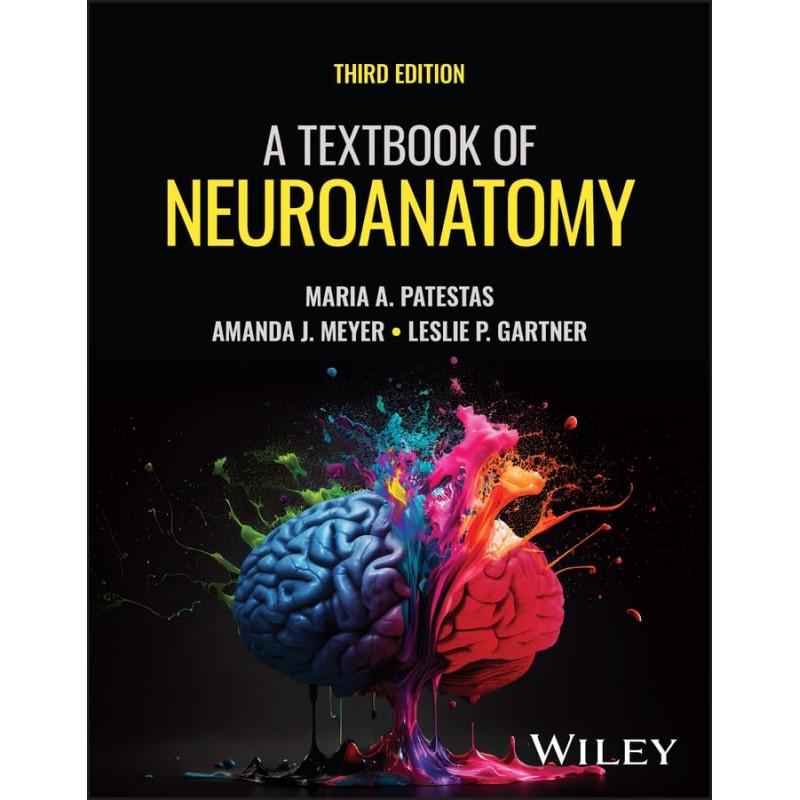A Textbook of Neuroanatomy, 3rd Edition
- ISBN: 9781394237067
- Εκδότης: WILEY BLACKWELL
- Σελίδες: 576
- Έτος Έκδοσης: 2025
123,00€
Χωρίς ΦΠΑ: 116,04€

Easily master the anatomy and basic physiology of the nervous system in this concise, student-friendly update of this distinguished textbook
A Textbook on Neuroanatomy has long served as the essential student introduction to the anatomy and systems of the brain. Covering brain organization, neural connections, and neural pathways in an accessible style, it contains the fundamental neurophysiology of every major brain area. Now fully updated to reflect the latest research and clinical data, it’s an essential resource for students in the life sciences with an interest in neuroscience.
Readers of the third edition of A Textbook on Neuroanatomy will also find:
A Textbook on Neuroanatomy is ideal for advanced undergraduate and graduate students in neuroscience, neurology, and general clinical behavioral neuroscience and neuroanatomy.
CONTENTS
Preface xi
Acknowledgments xiii
About the Companion Website xv
Part I General Principles of the Nervous System 1
Chapter 1 Introduction to the Nervous System 3
Cells of the Central Nervous System 5
Central Nervous System 6
Peripheral Nervous System 9
Questions to Ponder 10
Chapter 2 Development of the Nervous System 11
Clinical Case 11
Early Development 12
Neurulation 14
Early Development of the Spinal Cord and Brain 19
Development of the Spinal Cord 21
Development of the Brain 23
Clinical Considerations 30
Synonyms and Eponyms of the Nervous System 31
Follow-up to Clinical Case 31
Questions to Ponder 31
Chapter 3 Histophysiology of the Nervous System 32
Clinical Case 32
Neurons 33
Neuroglia 40
Generation and Conduction of Nerve Impulses 44
Clinical Considerations 47
Synonyms and Eponyms of Nervous System Histophysiology 48
Follow-up to Clinical Case 48
Questions to Ponder 48
Chapter 4 Neurotransmitter Substances 49
Clinical Case 49
Classification of Neurotransmitter Substances 52
Clinical Considerations 58
Follow-up to Clinical Case 59
Questions to Ponder 59
Chapter 5 Spinal Cord 60
Clinical Case 60
Morphology of the Spinal Cord 61
Internal Morphology of the Spinal Cord 67
Vascular Supply of the Spinal Cord 70
Clinical Considerations 73
Synonyms and Eponyms of the Spinal Cord 74
Follow-up to Clinical Case 74
Questions to Ponder 74
Chapter 6 Gross Anatomy of the Brain 75
Clinical Case 75
Cerebrum 76
Diencephalon 84
Cerebellum 85
Brainstem 87
Clinical Considerations 88
Synonyms and Eponyms of the Brain 90
Follow-up to Clinical Case 90
Questions to Ponder 90
Chapter 7 Brainstem 91
Clinical Case 91
Internal Organization of the Brainstem 91
Medulla Oblongata 96
Pons 102
Midbrain 107
Clinical Considerations 111
Synonyms and Eponyms of the Brainstem 116
Follow-up to Clinical Case 116
Questions to Ponder 116
Chapter 8 Meninges and Cerebrospinal Fluid 117
Clinical Case 117
Cranial Meninges 118
Spinal Meninges 126
Venous Sinuses of the Cranial Dura Mater 127
Cerebrospinal Fluid 130
Ventricles of the Brain 130
Clinical Considerations 131
Synonyms and Eponyms of the Cranial Meninges 132
Follow-up to Clinical Case 132
Questions to Ponder 132
Chapter 9 Vascular Supply of the Central Nervous System 133
Clinical Case 133
Vascular Supply of the Spinal Cord 134
Arterial Supply of the Brain 135
Venous Drainage of the Brain 149
Clinical Considerations 152
Synonyms and Eponyms of the Vascular Supply of the Central Nervous System 153
Follow-up to Clinical Case 153
Questions to Ponder 153
Chapter 10 Autonomic Nervous System 154
Clinical Case 154
Sympathetic Nervous System 157
Parasympathetic Nervous System 164
Enteric Nervous System 167
Neurotransmitters and Receptors of the Autonomic Nervous System 168
Pelvic Autonomic Functions 169
Clinical Considerations 171
Synonyms and Eponyms of the Autonomic Nervous System 172
Follow-up to Clinical Case 172
Questions to Ponder 172
Chapter 11 Spinal Reflexes 173
Clinical Case 173
Components of Reflexes 173
Lower Motor Neurons 174
Skeletal Muscle Innervation 175
Skeletal Muscle Receptors 176
Muscle Stretch Reflex 176
Reciprocal Inhibition 177
Autogenic Inhibition (Inverse Myotatic Reflex) 178
Flexor Reflex (Withdrawal Reflex, Nociceptive Reflex) 178
Crossed Extension Reflex 179
Maintenance of Muscle tone Via the Gamma Loop 180
Alpha–Gamma Coactivation 180
Synonyms and Eponyms of the Spinal Reflexes 182
Follow-up to Clinical Case 182
Questions to Ponder 182
Part II Integrative Components of the Nervous System 183
Chapter 12 Ascending Sensory Pathways 185
Clinical Case 185
Sensory Receptors 187
Anterolateral System 197
Tactile Sensation and Proprioception 207
Sensory Pathways to the Cerebellum 214
Clinical Considerations 218
Modulation of Nociception 226
Neuroplasticity 229
Synonyms and Eponyms of the Ascending Sensory Pathways 229
Follow-up to Clinical Case 230
Questions to Ponder 230
Chapter 13 Motor Cortex and Descending Motor Pathways 231
Clinical Case 231
Cortical Areas Controlling Motor Activity 232
Descending Motor Pathways 235
Clinical Considerations 249
Synonyms and Eponyms of the Motor Cortex and Descending Motor Pathways 253
Follow-up to Clinical Case 254
Questions to Ponder 254
Chapter 14 Basal Nuclei 255
Clinical Case 255
Components of the Basal Nuclei 256
Nuclei Associated with the Basal Nuclei 260
Input, Intrinsic, and Output Nuclei of the Basal Nuclei 261
Connections of the Basal Nuclei 263
Circuits Connecting the Basal Nuclei, Thalamus, and Cerebral Cortex 270
Other Circuits of the Basal Nuclei 273
Neurotransmitters of the Basal Nuclei 274
“Direct,” “Indirect,” and “Hyperdirect” Loops (Pathways) of the Basal Nuclei 275
Circuits that Modulate Activity of the Basal Nuclei 277
Clinical Considerations 278
Synonyms and Eponyms of the Basal Nuclei 283
Follow-up to Clinical Case 284
Questions to Ponder 284